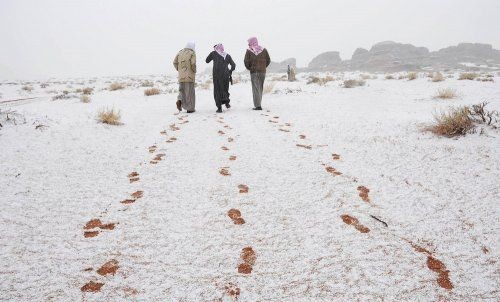Snow in Saudi Arabia??
When we picture a desert all we can imagine is a miles and miles of endless sand under a scorching sun with temperature reaching upto 58 degree Celsius, making the sand a hot pan, no vegetation to be seen and not to forget no water. Snow fall in desert is the last thing you would have expected. But it happened anyway.
Recently in the Saudi Arabia desert the temperature dropped upto -2 degree Celsius resulting in the snow across Saudi kingdom. This unusual effect excited people in those areas, posting pictures across social media. In the Aseer region, which is south of Mecca along the coast of the Red Sea was the region encountered most snow fall, it was seen in other parts too.
First time in 50 years Saudi have experienced such phenomenon making it one of the rare event.
Not only Saudi, Sahara desert too experienced snow. Ain Sefra, a town in western Algeria situated on the Saharan atlas mountains (also known as gateway to desert) experienced this rare phenomenon. From usual temperature of 30–50 degree Celsius, Sahara desert reached -2 degree Celsius resulted in the formation of snow pallets in sand. However this snow pellets lasted only for few hours according to locals. Unlike Saudi, Sahara have experienced this 4 times in half a century.
Strangely 2020 was named hottest year and next year we see such low temperature.
So how did this happen? We all would have read that sands lose there temperature lot sooner than humid air, those making day hotter and night colder. Now, winds moves from high pressure hemisphere to low pressure hemisphere in clockwise manner.
Centre Europe experienced high pressure resulting in bringing cold artic wind across southern Europe, resulting in snow formation in Saudi Arabia and parts of Sahara.
According to few articles like the Global citizen, these are the effects of global warming causing unusual temperature change across world.
“Such situations, including snowfalls in Sahara, a long cold spell in North America, very warm weather in the European part of Russia and sustained rains which sparked flooding in Western European countries, have been occurring more frequently,” said Roman Vilfand, head of Russia’s Federal Service for Hydrometeorology and Environmental Monitoring.

